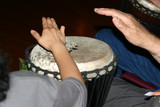Fun Hand Percussion for Kids

We all know that it’s important for children to learn to play an instrument. Learning to play a musical instrument helps increase cognitive abilities like memory and learning and reduces anxiety and stress. Childhood can definitely be a stressful time of life, which is why music programs in schools are so important. Of course, school is not the only place children can or should let loose with a musical instrument. In fact, the earlier children begin a regular musical practice, the more it benefits them as they get older so it’s good to promote fun percussion for kids at as early an age as possible.
The percussion instrument family is rather large and varied, with instruments for every skill level and just about any interest. Kids tend to enjoy making noise, so getting them interested in percussion isn’t a generally difficult task. With the different types of percussion instruments available, it’s also a pleasure to find that so many are perfectly geared toward the younger set. We used to think of fun percussion for kids as bells, triangles, and tambourines. However, these days we can find djembes in smaller sizes perfect for young children just starting out. In fact, it is easy to find all sorts of kid-sized, high quality instruments.
The djembe is a great starter instrument for budding percussionists. It is a common enough instrument, so kids are likely to feel part of their community when they bring their own djembe out to play. Also, it is a serious instrument that kids can get a feel for as they get older. Fun percussion for kids is not only about allowing the kids to make noise; as they grow older, their desires to emulate the adults around them should be respected. With small djembes in both tunable and untunable versions, kids can find what works for them as they hone their skills.
Of course, djembes are not the only fun percussion instrument for kids. There are still the traditional percussion kits that include maracas, claves, rhythm sticks, and the like. There are also cajons specially sized for the younger crowd. Combined with some ankle bells, a cajon might make the perfect introduction into the world of percussion for some children. Since it is an instrument still growing in popularity, it may appeal to kids who enjoy being different from those around them. Doumbeks are another small drum, making them another perfect drum for kid percussionists.
A love for percussion is something that often starts in very young children, beginning with those first drums called pots. As people begin to find more support for the importance of making music, it is becoming easier to find instruments perfectly suited to percussion fun for kids. Whether bongos or a tubano, playing the drums is a great way to navigate the terrain of humanity and the younger a kid starts, the better.
Recent Posts
-
X8 Drums Play-Along Backing Tracks
The new X8 Play-Along Series is being produced for our musician friends wanting a fresh way to work …9th Feb 2025 -
What is the Best Size Djembe for Beginners?
If you're new to the world of percussion and interested in learning the djembe, you're in for a t …16th Jul 2024 -
The Benefits of Becoming a Drumming Teacher: Transforming Passion into Profession
Why become a drumming teacher? Becoming a drumming teacher is an excellent way to share your pas …22nd May 2024



